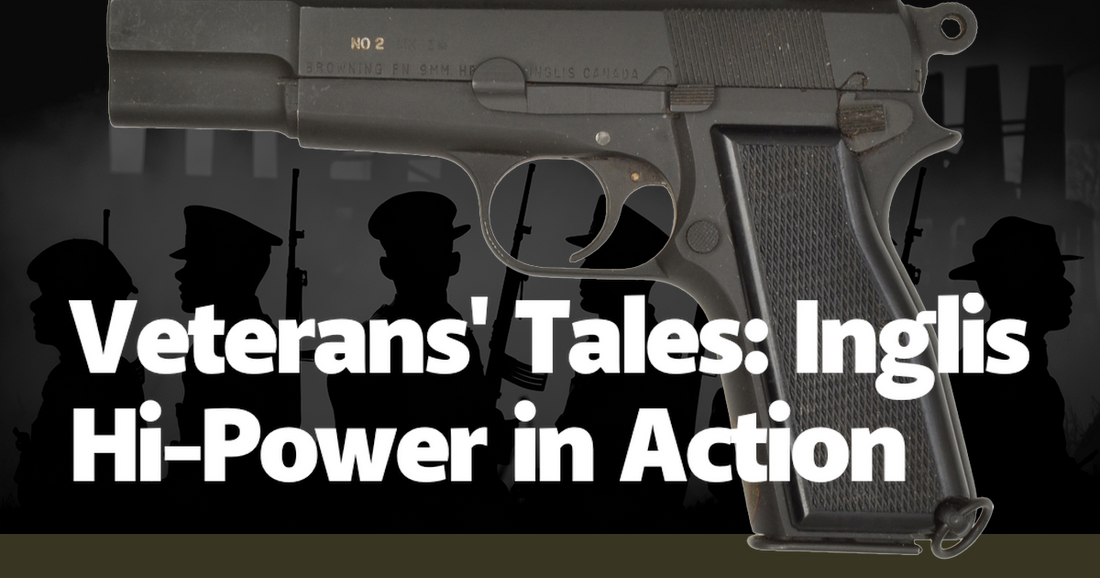The Inglis Hi-Power, a Canadian-made variant of the Browning Hi-Power, has etched its name into the annals of military history through the tales of veterans who wielded it in various theaters of war. First produced during World War II, this semi-automatic pistol became a symbol of reliability and precision. The Hi-Power was a favored sidearm for many Allied forces, including the British and Canadian armies. Its legacy is not merely rooted in its mechanical excellence but in the stories of those who carried it into battle. Veterans recounting their experiences with the Hi-Power often speak of its balance, accuracy, and the sense of confidence it inspired in the heat of combat.
One such tale comes from Sergeant James O’Hara, a Canadian soldier who served in the Italian Campaign. O’Hara’s unit was tasked with clearing a small village held by entrenched Axis forces. As they advanced through the narrow, winding streets, O’Hara found himself separated from his squad. Cornered by enemy soldiers, he relied on his Inglis Hi-Power to fight his way out. The pistol’s 13-round magazine and smooth trigger pull allowed him to engage multiple targets quickly and efficiently. O’Hara later recounted how the Hi-Power’s reliability under pressure saved his life that day, transforming it from a mere tool of war into a trusted companion.
The Inglis Hi-Power also played a pivotal role in the clandestine operations of the Special Operations Executive (SOE) and the Office of Strategic Services (OSS). These elite units required a sidearm that was both dependable and concealable. The Hi-Power, with its compact design and robust construction, fit the bill perfectly. Agents like Major John Smith, who operated behind enemy lines in occupied France, often carried the Hi-Power during their missions. Smith’s memoirs detail a harrowing encounter where he narrowly escaped capture, crediting the Hi-Power’s quick draw and accurate fire for his survival. Such accounts highlight the pistol’s importance in covert operations, where every shot could mean the difference between life and death.
In the post-war years, the Inglis Hi-Power continued to serve in various conflicts, including the Korean War and the Vietnam War. Veterans from these eras also share stories of the pistol’s effectiveness. Corporal Thomas Nguyen, a Vietnamese soldier who fought alongside American forces, recalled an ambush where his unit was pinned down by enemy fire. His Hi-Power became his lifeline, allowing him to return fire with precision and hold the line until reinforcements arrived. Nguyen’s story is a testament to the enduring legacy of the Hi-Power, proving its worth across different terrains and combat scenarios.
The Hi-Power’s influence extended beyond the battlefield into the training grounds of military and law enforcement agencies. Its design, featuring a high-capacity magazine and a user-friendly safety mechanism, made it an ideal training tool for new recruits. Lieutenant Sarah Thompson, an instructor at a military academy, often used the Hi-Power in her firearms training courses. She noted that its manageable recoil and consistent performance helped build confidence in her students, many of whom would go on to serve in various conflict zones around the world. The Hi-Power’s role in shaping the skills of future soldiers and officers cannot be overstated.
Even in the modern era, where advanced firearms have taken center stage, the Inglis Hi-Power remains a beloved piece of military history. Collectors and enthusiasts often seek out this iconic pistol, drawn by its storied past and mechanical excellence. Military museums around the world display the Hi-Power with pride, preserving the tales of bravery and resilience associated with it. The pistol serves as a tangible link to the past, a reminder of the sacrifices made by those who carried it into battle. For many veterans, the Hi-Power is more than just a weapon; it is a symbol of their service and the bonds forged in the crucible of war.
The Inglis Hi-Power’s design has also influenced modern firearms. Its double-stack magazine and ergonomic grip have been incorporated into many contemporary pistols, ensuring that its legacy lives on in the hands of today’s soldiers and law enforcement officers. The Hi-Power’s impact on firearm design is a testament to its innovative engineering and the forward-thinking vision of its creators. Veterans who have transitioned to roles in law enforcement or private security often find themselves gravitating towards pistols that share the Hi-Power’s characteristics, a nod to the lasting impression it left on them during their military service.
Ultimately, the Inglis Hi-Power is more than just a piece of military hardware; it is a repository of stories, a witness to countless acts of heroism and sacrifice. The veterans’ tales of the Hi-Power in action serve as a powerful reminder of the human element in warfare. Each story, whether of survival, victory, or loss, adds a layer of depth to the Hi-Power’s legacy. In the hands of those who served, it became a symbol of resilience and determination, a silent partner in the fight for freedom. The Inglis Hi-Power’s place in history is secure, not just as a remarkable firearm, but as a testament to the courage and tenacity of the soldiers who carried it.

